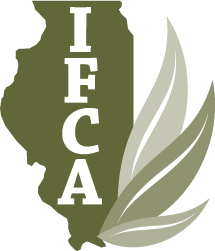Fall Nitrogen - BMPs and Water Quality
3. Use a USEPA labeled nitrification inhibitor with all fall-applied ammonia (N-Serv and Centuro). These products are registered as pesticides because they inhibit bacterial activity that can convert ammonium to nitrate. These bacteria are active until the soil freezes. The inhibitor is intended to provide protection against nitrification in the late fall, early winter and spring. This chart shows how fast ammonium converts to nitrate at various temperatures. Protecting the ammonia with a nitrification inhibitor helps a great deal, but when soils remain warm that protection can be used up more quickly.
In priority watersheds including Lake Springfield, Lake Decatur, Lake Vermilion and Lake Bloomington, it is especially important to follow these guidelines, or consider applying nitrogen in the spring in fields close to these lakes. We continue to see nitrate levels rise in late winter and early spring in these drinking water supplies, sometimes to concerning levels.
NREC funded research shows that there is no yield penalty for applying N in the fall, but there is a water quality penalty especially in tile drained fields. NREC research shows that fall applied N loses up to 12 lbs more per acre than N applied in the spring. See this presentation from the 2020 IFCA Convention that shows the data from the research. This presentation also shows how phosphorus applied on frozen or snow covered soils results in increased losses of phosphorus to surface waters. That issue is further examined in the December 2019 Bulletin from UI.
The UI published a bulletin on Sept 29 discussing fall applied N, and Iowa State University provided similar guidance.
IFCA knows that following these guidelines can create economic challenges for retailers and farmers. We all remember two years ago when many waited for the soils to get to 50 degrees, only to be rained out and not have an opportunity to apply at all. Then the ammonia contracts were cancelled at year-end. The saying "no good deed goes unpunished" fits. We have to keep in mind, however, that many eyes are on our industry, and we've made commitments to adhere to voluntary measures to reduce nutrient losses in accordance with the INLRS. What we've placed in this Alert is exactly what is in the INLRS as examples of voluntary agriculture activities to reduce nutrient losses.
As always, contact IFCA with questions, concerns or just to vent. We are here for you and to also ensure the good practices of our industry members are shared with other water quality stakeholders, even when things are difficult.
